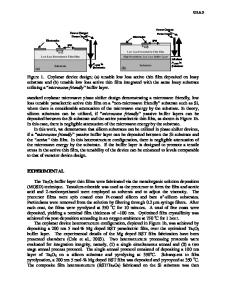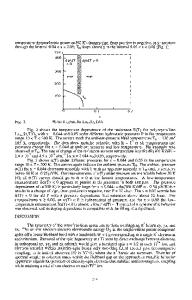Tunability in Ba 1- x Sr x TiO 3 -based Ferroelectrics
- PDF / 86,161 Bytes
- 6 Pages / 612 x 792 pts (letter) Page_size
- 11 Downloads / 278 Views
Tunability in Ba1–xSrxTiO3-based Ferroelectrics Daniel M. Potrepka, Steven C. Tidrow, and Arthur Tauber Sensors and Electron Devices Directorate, Army Research Laboratory, Adelphi, MD 20783-1197, U.S.A. ABSTRACT Ferroelectrics are presently of interest for phase shifters, filters, and true time delay devices. Voltage tunable paraelectrics have the potential to lower device cost and reduce power consumption compared with presently available devices. In order to improve device performance to acceptable levels, materials must have high tunability, low dielectric constant, low loss tangent, and low leakage current. Using existing predictive techniques, compositions of Ba0.6Sr0.4TiO3-based ferroelectrics with charge-compensated substitutions for Ti4+ were synthesized. Results of capacitance measurements are used to obtain dielectric constant and tunability in the paraelectric (T > TC) regime. The relevance to device requirements is discussed. Results for substituted samples are compared to those for (unsubstituted) Ba0.6Sr0.4TiO3. Discussion of the impact of the results on predictive techniques for tunability is addressed. INTRODUCTION Ferroelectrics are of interest in the paraelectric regime for voltage-tunable, radiofrequency, and microwave phase shifters, filters, and true-time delay devices for electronic scanning antenna technology. Materials requirements include low dielectric constant, high tunability, low losses and low leakage current [1,2]. Bulk BST has a limited temperature range for applications at all Sr contents, ~ 10 % of the mil spec range, due to its sharp ferroelectric transition [3]. At Tc, the losses are too high. In the paraelectric regime, where ε(T) becomes temperature independent, large driving voltages become necessary to obtain tuning in BST for samples of typical thickness. Therefore, the role of bulk BST in device applications is restricted to a limited temperature range defined by the particular Sr content, which acts primarily to shift Tc. In contrast, a two-phase bulk compound, one of the phases being single-phase BST and the other MgO, has desirable properties over a larger temperature range [2]. A thin film technology would need to be developed in order to lower voltages further. This may be complicated due to difficulties in depositing a two-phase material. However, unmodified Ba1-xSrxTiO3 (BST) thin film materials can be used to obtain tuning at lower voltages and broaden the temperature range of operation due to effects such as stress and strain. Studies of how the dielectric properties of bulk and thin film BST can be improved and made more constant as a function of temperature are therefore important. In this study, the effect that dilute charge-balanced substitutions onto the Ti4+ site of BST has on the dielectric properties in the paraelectric regime is addressed. In particular, the temperature dependence is analyzed and discussed in the context of the mil spec. EXPERIMENTAL DETAILS Charge-balanced substitutions for Ti4+ were made using X 4+ = Ge, Sn and Zr to obtain Ba0.6Sr0.4X0.0
Data Loading...











